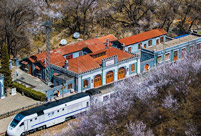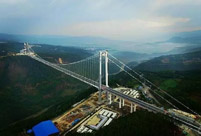

A driverless vehicle developed by the internet giant Baidu on display in December at an exposition in Wuzhen, Zhejiang province.XU YU/XINHUA
However, there are still challenges, and right now the biggest obstacle to full commercialization is the high cost of the vehicles.
Based on advanced hardware-sonar devices, stereo cameras, lasers and radar, together with complex self-driving software-the cost of an autonomous car will be $7,000 to $10,000 higher than that of a traditional vehicle by 2025, according to a report by IHS, an auto industry consultancy, which said technological developments will see the price premium drop to around $5,000 in 2030 and $3,000 in 2035.
LiDAR, a laser radar system that Google installs on the roofs of vehicles to provide a 3-D picture of the surroundings, costs between $75,000 and $85,000, which means it is too expensive to be fitted in commercial vehicles.
Even after the supplier, Velodyne Acoustics, introduced a cut-price, minimal system at a cost of $30,000 to $40,000 in 2014, only automakers and suppliers could afford to buy the technology for testing purposes.
That offers an opportunity to Chinese entrepreneurs, whose forte is squeezing costs.
In December, Baidu tested two prototypes of autonomous cars-BMW 3 Series Gran Turismo models-priced at 400,000 yuan to 700,000 yuan ($61,520 to $107,660). Both cars were fitted with LiDAR systems that cost 700,000 yuan each.
"Such a high price will only be feasible at the testing stage, it will definitely need to be reduced substantially when being commercialized in the future," said Wang Jin, who runs Baidu's autonomous driving division, quoted in Shanghai's The Paper in December.
By using the word "substantially", Wang was making it clear that he expects the price of lower-resolution guidance models to fall by about 90 percent, not the 50 percent sugg-ested by suppliers such as Velodyne Acoustics.
In March, Wang told the media that the company is cooperating with suppliers and hopes to reduce the cost of the radar system to about 20,000 yuan-2.85 percent of the cost of the LiDAR system used in December-in three to five years, by which time Baidu will begin mass production of driverless cars.
So far, Baidu has managed to reduce the cost to less than 200,000 yuan (less than one-third of the original cost), he added.
Previous Page12345Next Page Previous Page12345Next Page
 |  |
 French girl ties the knot with Chinese boy
French girl ties the knot with Chinese boy Beijing Style: ready for bare legs
Beijing Style: ready for bare legs Century-old station sees railyway evolution
Century-old station sees railyway evolution Enthusiasts perform Kung Fu at Wudang Mountain
Enthusiasts perform Kung Fu at Wudang Mountain Stunning photos of China's fighter jets in drill
Stunning photos of China's fighter jets in drill Monk's mummified body to be made into a gold Buddha statue
Monk's mummified body to be made into a gold Buddha statue Former Chinese solider of the French Foreign Legion seeks wife online
Former Chinese solider of the French Foreign Legion seeks wife online Asia's longest and highest suspension bridge to open to traffic
Asia's longest and highest suspension bridge to open to traffic China's first interactive robot looks like a beauty
China's first interactive robot looks like a beauty Top 20 hottest women in the world in 2014
Top 20 hottest women in the world in 2014 Top 10 hardest languages to learn
Top 10 hardest languages to learn 10 Chinese female stars with most beautiful faces
10 Chinese female stars with most beautiful faces China’s Top 10 Unique Bridges, Highways and Roads
China’s Top 10 Unique Bridges, Highways and Roads EU decision seen harming China ties
EU decision seen harming China ties Society firmly rejects Cultural Revolution
Society firmly rejects Cultural Revolution Villagers living near Vietnam border are still haunted by war’s legacy
Villagers living near Vietnam border are still haunted by war’s legacy As Chinese sci-fi picks up steam, it’s finding fans around the world
As Chinese sci-fi picks up steam, it’s finding fans around the worldDay|Week